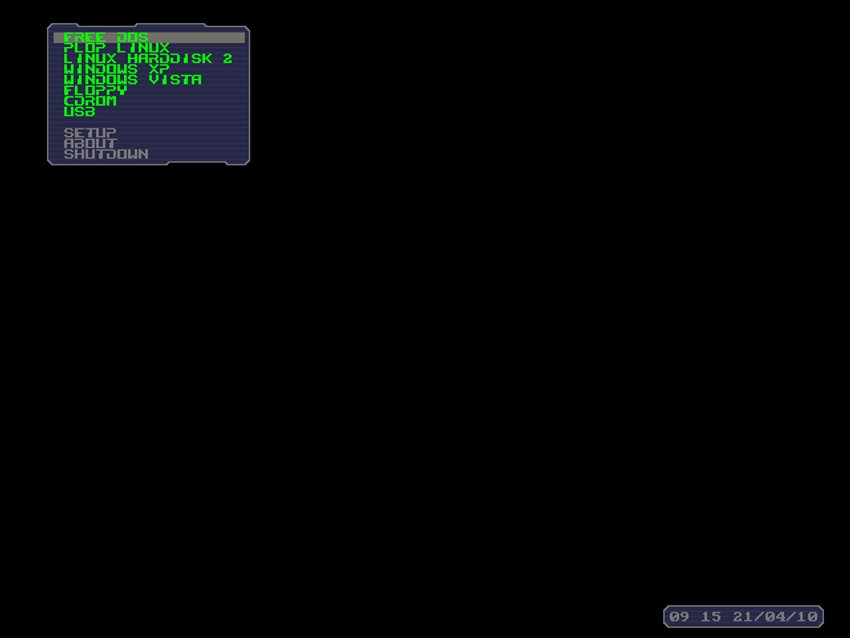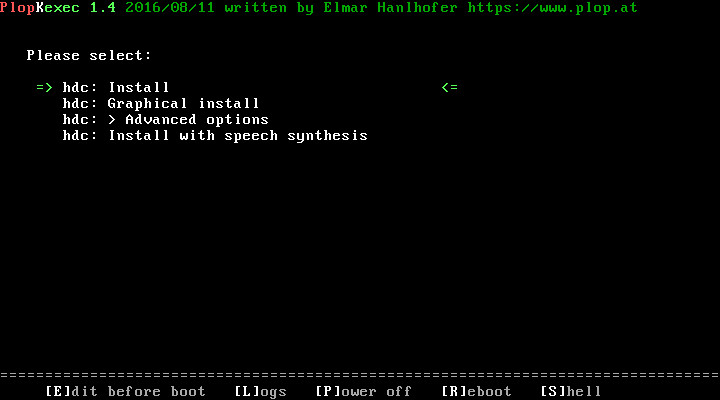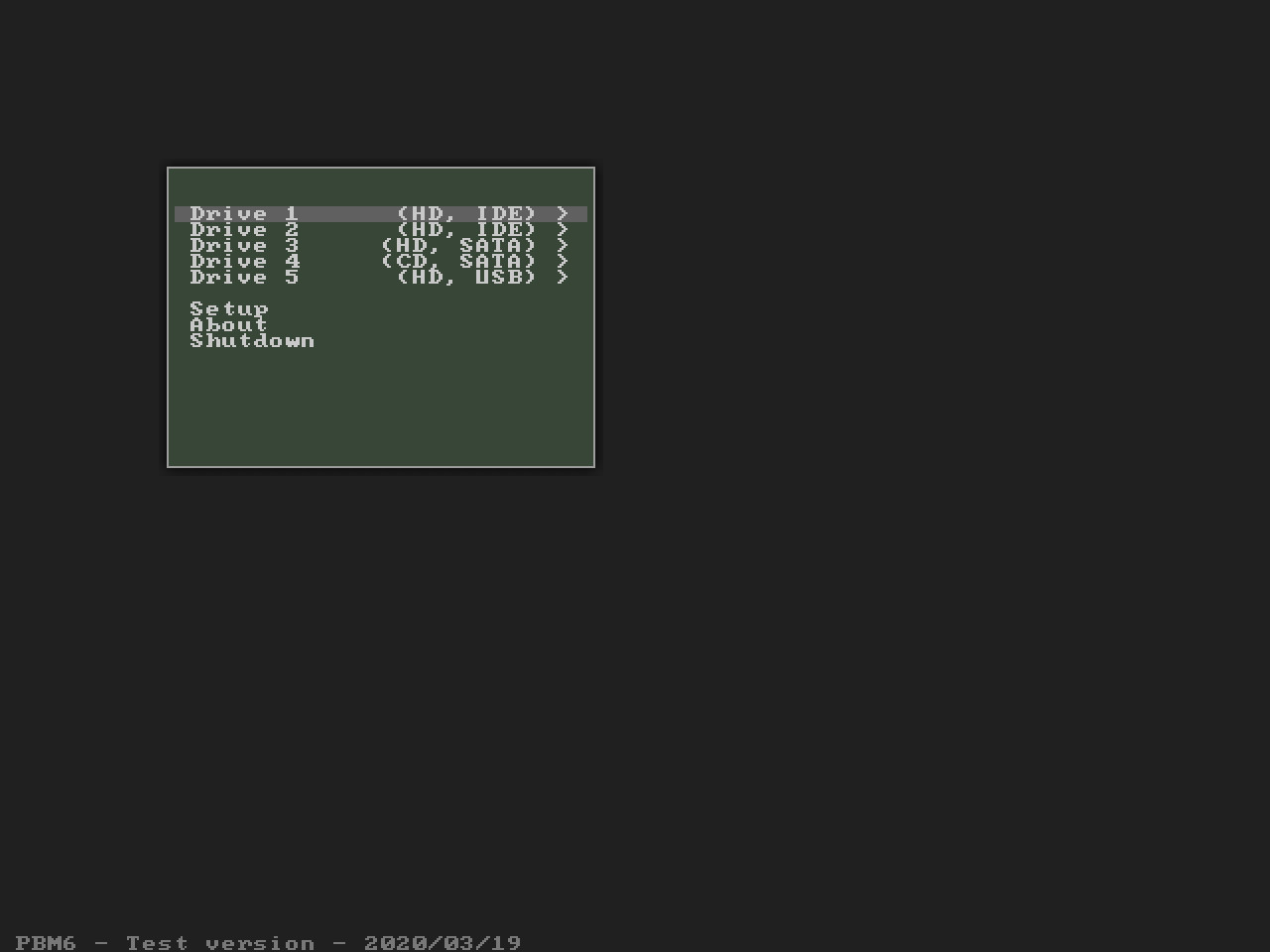- Boot Managers
- The Boot Manager
- 1. Hotkeys — Global keys
- 2. Main menu
- 2.1. Main menu hotkeys
- 3. Setup
- 3.1. Partitions
- Edit label
- Select Device
- Partition ID
- 1. Enter partition ID
- 2. Select ID from list
- Edit MBR/Import data
- Clear partition data
- Reset changes
- 3.2. Profiles
- Edit label
- Show in main menu
- Linked partitions
- Configure partition entries
- 1. a selected partition
- 2. don’t touch
- 3. cleared
- Linked partitions — hotkeys
- Clear profile data
- Reset changes
- 3.3. Boot manager
- Startmode
- Boot countdown
- Edit boot countdown
- Select at start
- 1. Last booted profile
- 2. Default profile
- 3. Floppy
- 4. CDROM
- 5. USB
- Default profile
- Show floppy boot
- Show cdrom boot
- Show usb boot
- Force USB 1.1
- Use Mass Stor Dev
- Text mode after boot
- Graphicmode
- Zoom animation
- Starfield
- Master password
- Setup password
Boot Managers
I wrote different boot managers. Three boot managers are available as download. The Plop Boot Manager 5, PlopKexec and the new boot manager PBM6. The new boot manager is under development.
Boot Manager Comparison Chart Plop Boot Manager 5 PlopKexec Plop Boot Manager 6
PBM6Version 5.0.15 1.6 Test Release Date 15/Apr/2013 14/Sep/2019 09/Sep/2021 Install to MBR YES NO NO Install into BIOS as Option Rom YES NO NO Can be started from Syslinux, GRUB, LILO YES YES YES Network YES YES YES Windows Boot Menu YES NO YES Floppy YES NO YES CD/DVD YES YES YES USB YES YES YES UEFI NO YES YES Can boot IDE/SATA Hard Disk YES YES YES USB Thumb Drive/Hard Disk YES YES YES IDE CD/DVD YES YES YES SATA CD/DVD NO YES YES USB CD/DVD NO YES YES Floppy YES NO NO MBR / Logical Limited YES YES Support for GPT NO YES YES Boot other OS than Linux YES NO YES Native Drivers IDE YES YES YES SATA NO* YES YES USB 1.1 UHCI, OHCI YES YES YES USB 2.0 EHCI YES YES YES USB 3.0 xHCI NO YES YES USB Thumb Drive/Hard Disk YES YES YES USB Keyboard NO** YES YES USB HUB NO YES YES USB CD/DVD NO YES YES PCMCIA Limited YES NO Various Configure OS partition profiles YES NO NO Hide partitions YES NO NO Hidden boot YES NO NO Password protection YES NO NO Open Source NO YES NO Support for blind people NO NO YES Screenshots
* SATA drives can be used anyway.
** USB Keyboards can be used until the USB boot option has been selected. Then it will be usable again when Linux or Windows booted.
Источник
The Boot Manager
1. Hotkeys — Global keys
Cursor up/down Move the bar Enter Choose selection ESC Close window CTRL — ESC Switch to text mode CTRL — PAGE UP Switch to higher screen resolution CTRL — PAGE DOWN Switch to lower screen resolution z Enable/Disable window zoom animation
2. Main menu
In the main menu you see all visible profiles to boot an operating system. You can start an operating system from floppy, cd/dvd, usb or network. You can go to the setup of the boot manager, partitions and profiles. If your bios supports APM, you can shut down your computer.
2.1. Main menu hotkeys
1-9 Boot profile q Quick boot, open a list of all possible hardcoded partitions to boot w Write MBR with the profile settings, but do not boot f Boot floppy c Boot CD/DVD u Boot USB n Network boot
Special additional keys for USB boot:
Press SHIFT-u to force USB 1.1
Press CTRL-u to wait for a key press before starting the operating system. When a drive was found, then you can press «s» to skip the device or you can boot from the drive.
Press ALT-u to wait for a key press before detecting the usb device type. When a device was found, then you can press «s» to skip the device or you can boot from the device when it’s as mass storage device.
Difference CTRL-u and ALT-u:
- When you use CTRL-u and the boot manager finds an usb device, then the boot manager identifies it. Because of the stripped down usb implementation, it’s possible that the boot manager sometimes hangs on some computers. With ALT-u, the identification of the usb drives happens when you press enter. When you press «s», then the boot manager skips the device and it should not hang.
3. Setup
3.1. Partitions
You can manage your partitions here. The install program creates an entry for all primary partitions it finds. The names are from HDA1 up to HDD4 . HD means hard disk. HDA stands for hard disk A and is the first hard disk. The numbers 1-4 are the numbers of the primary partitions.
Notice for linux users: HDA has nothing to do with the devices in linux like /dev/hda .
Edit label
You can change the label for the partition. This label is used in the boot manager. The maximum length is 16 chars.
Select Device
Here, you choose the hard disk of the partition.
HDA = Hard disk 1
HDB = Hard disk 2
HDC = Hard disk 3
HDD = Hard disk 4
Partition ID
There are 2 ways to set the ID of a partition.
1. Enter partition ID
You can enter the hexadecimal value for the partition.
2. Select ID from list
This list has the mostly used partition ID’s. If the requested ID is not in the list, then use Enter partition ID .
Edit MBR/Import data
This is used to change the values of partitions in the MBR.
BP means boot manager partition. This values are stored in the boot manager.
P1-P4 this are the current values of the primary partitions in the MBR.
You can edit the hexadecimal values in the partition table. You can select a row with s (select) and paste the values to the row where the cursor is with p . With this function, you can import partition values to the boot manager or change values in the MBR. This can be very useful in emergency cases.
Clear partition data
Clearing the data means clearing of the partition data in the boot manager. The data on the partition itself is unchanged.
Reset changes
Use it if you changed something and you want to restore the whole values of the partition in the boot manager. This is possible until you close the partition edit window.
3.2. Profiles
Profiles are used to start different operating systems from different hard disks and partitions. It’s also possible to detect changes in the MBR made by other software and import or forget the changes.
If you have an operating system installed and you install the boot manager, the installer creates a profile to boot the current operating system.
Edit label
You can edit the label of the profile. This label is shown in the main menu. It’s useful to use a label to see what operating system is going to boot. The maximum length is 16 chars.
Show in main menu
With this option you select if the profile is shown in the main menu or not. Only visible profiles can be booted. It also has effects on the default profile in the boot manager setup.
Linked partitions
You select from which hard disk, partition and bios device number you want to boot with this profile. You can also select what partitions or cleared partitions should be used for the MBR.
Configure partition entries
There are 3 states for a partition entry
1. a selected partition
Press enter to choose a partition from a list with all partition of this hard disk available from Partitions .
If another software changes this entry in the MBR, the boot manager detects this change at the next startup. You can choose if you want to import the new values or forget them.
2. don’t touch
The partition entry in the MBR will not be changed from the boot manager. That is the default setting.
If a software changes this entry in the MBR the boot manager cannot detect this change.
3. cleared
The boot manager set’s this entry to 0 in the MBR. An operating system cannot detect that there is/was a partition.
WARNING: if the boot manager has not stored the values of the partition in «Partitions» then you lose the partition values in the MBR and you cannot access the data on the partition. It’s possible to restore those values, but it’s better, easier and safe to store the values in Partitions .
Partition programs will say this is unallocated space! Do not partition this space! You can lose data if you do it wrong.
Linked partitions — hotkeys
b set boot partition. You select, what partition you want to boot with this profile. The boot manager set a bios drive number automatically. It’s possible to change it with another key.
c clear partition. You set this entry to «cleared» and the boot manager clears this entry in the MBR when you boot this profile.
d don’t touch. You set the entry to don’t touch and the boot manager does not change this entry when you boot this profile.
e edit boot flag. The boot flag has the bios drive number used by the boot sector routine. In some cases it’s required to change this value.
r remove boot flag. Here, you remove the boot flag from the profile.
l set logical partition. You can set to boot from a logical partition 1-4 of an extended partition. Change the logical number by pressing «l». L1 = first logical, L2 = second, .
Clear profile data
You can clear the profile data in the boot manager. The data in Partitions are not changed.
Reset changes
Use it if you changed something and want to restore the whole values of the profile in the boot manager. This is possible until you close the profile edit window.
3.3. Boot manager
Startmode
The boot manager has two modes to start. With the user interface menu and hidden .
For the hidden mode, you have to set the boot countdown and you have to select a default profile . The default profile boots after the countdown. The user cannot see that there is a boot manager in the background. If you want to go into the boot manager, then press ESC .
Boot countdown
You can enable and disable the countdown.
If the boot countdown is enabled, the boot manager waits the given time and starts after the countdown the last used profile or the default profile, depending on your settings.
Edit boot countdown
Choose between 1 and 99 seconds.
Select at start
At start, the boot manager set the bar to the selected option. This works for the hidden start mode too.
You have the following options
1. Last booted profile
2. Default profile
3. Floppy
4. CDROM
5. USB
Default profile
You can select the default profile from a list of all visible profiles.
Show floppy boot
Show the floppy boot option in the main menu.
Show cdrom boot
Show the cdrom boot option in the main menu.
Show usb boot
Show the USB boot option in the main menu.
Force USB 1.1
Use USB 1.1 controller even if there is a USB 2.0 controller.
Mode 1: Ignore the EHCI Controller
Mode 2: Setup EHCI Controller and set all ports to the companion host. Some controllers need this option to force usb 1.1.
Use Mass Stor Dev
Use Mass Storage Device. Boot the X mass storage device that was found. Other devices are ignored.
Text mode after boot
You can select the text mode during the startup of an operating system. Choose between «don’t change» and 80×50.
Graphicmode
Select the screen resolution in the boot manager. Choose between text mode 80×50 and graphic mode 640×480, 800×600, 1024×768, 1280×1024.
Zoom animation
Enable and disable the window animation.
Select the boot manager font or the bios font.
Starfield
Enable and disable the starfield animation.
Master password
Setup the master password. Disable the boot manager password protection with an empty password.
Setup password
Setup the setup password. Disable the boot manager setup password protection with an empty password.
Источник






